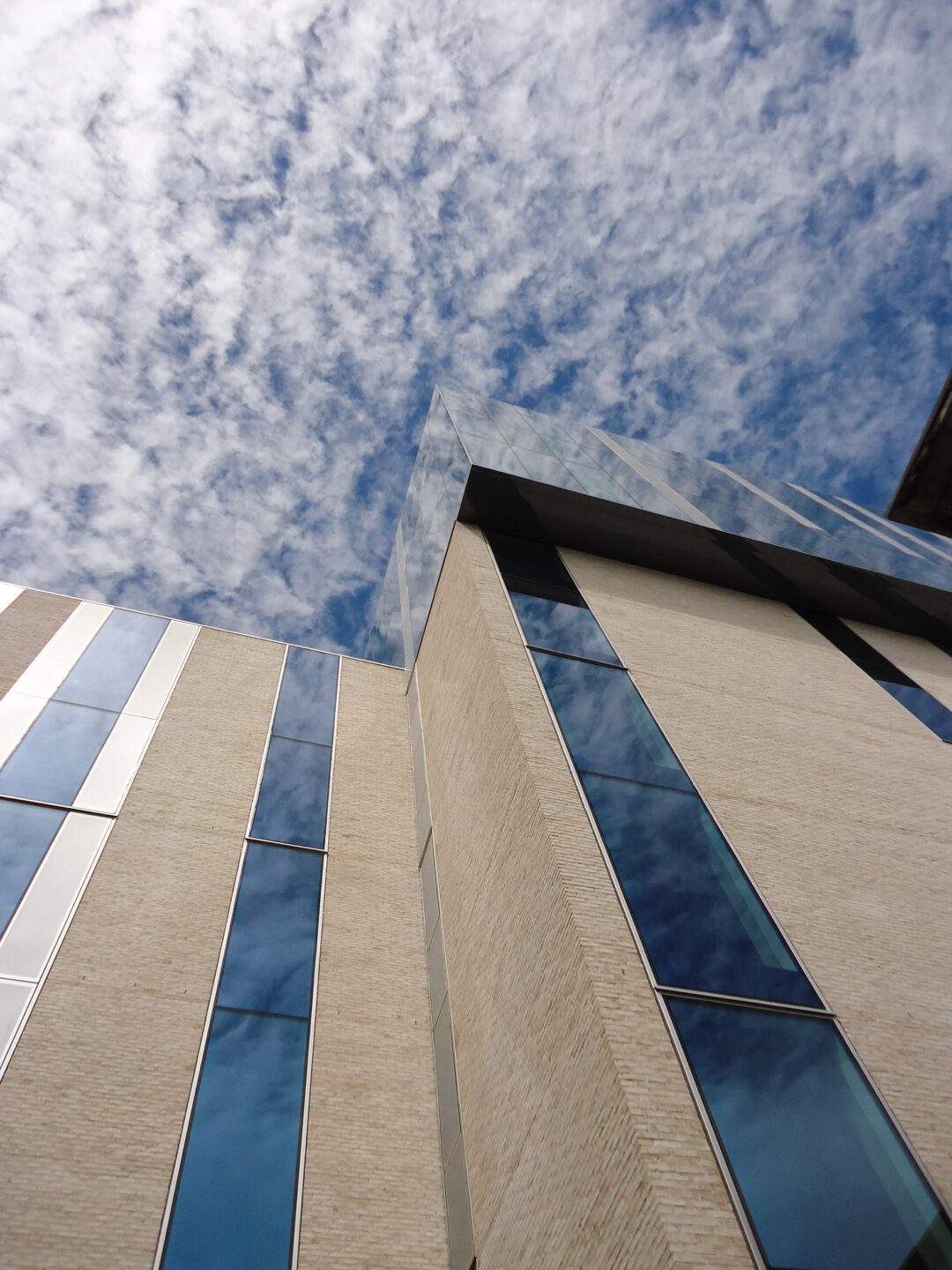


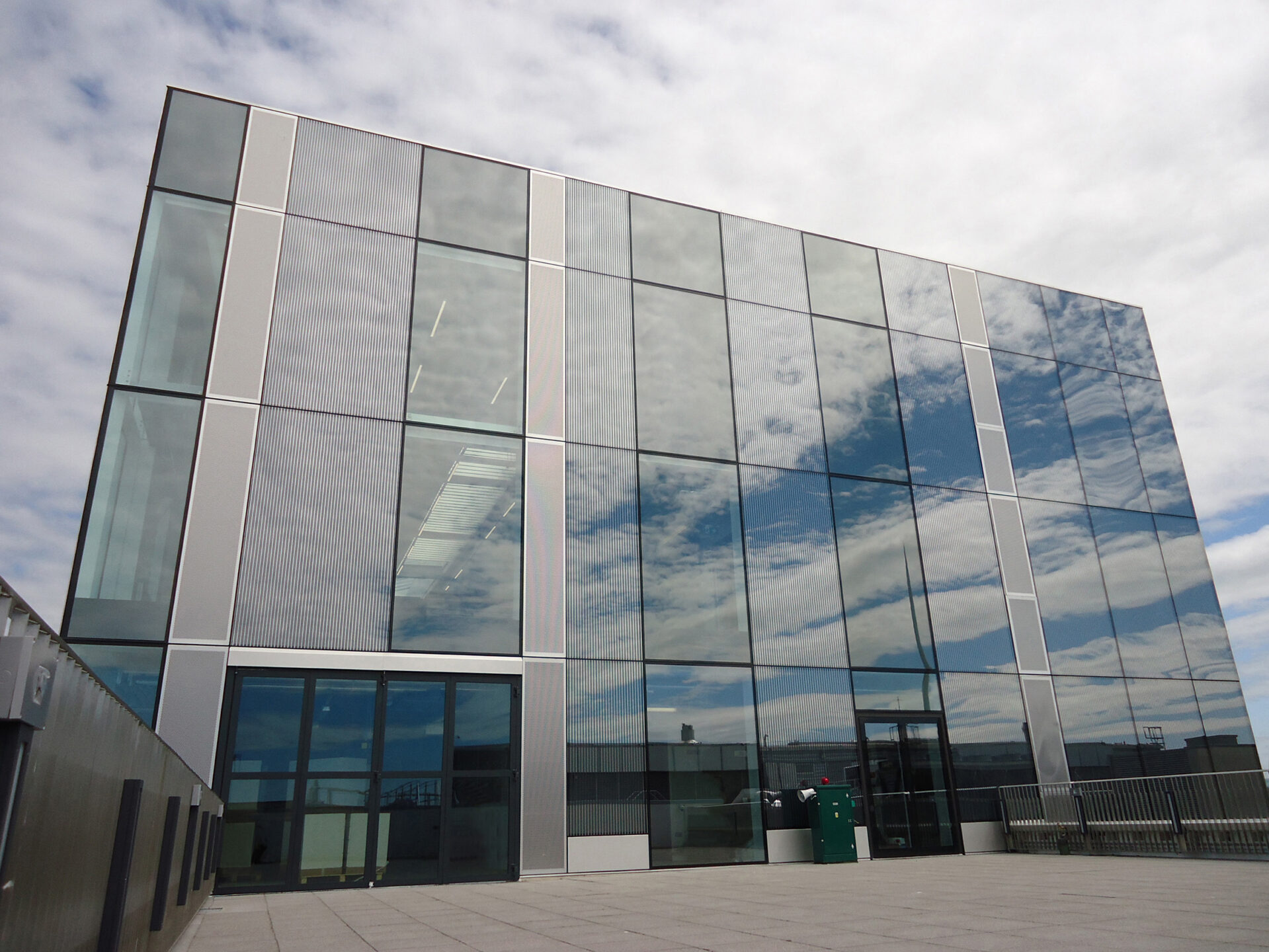
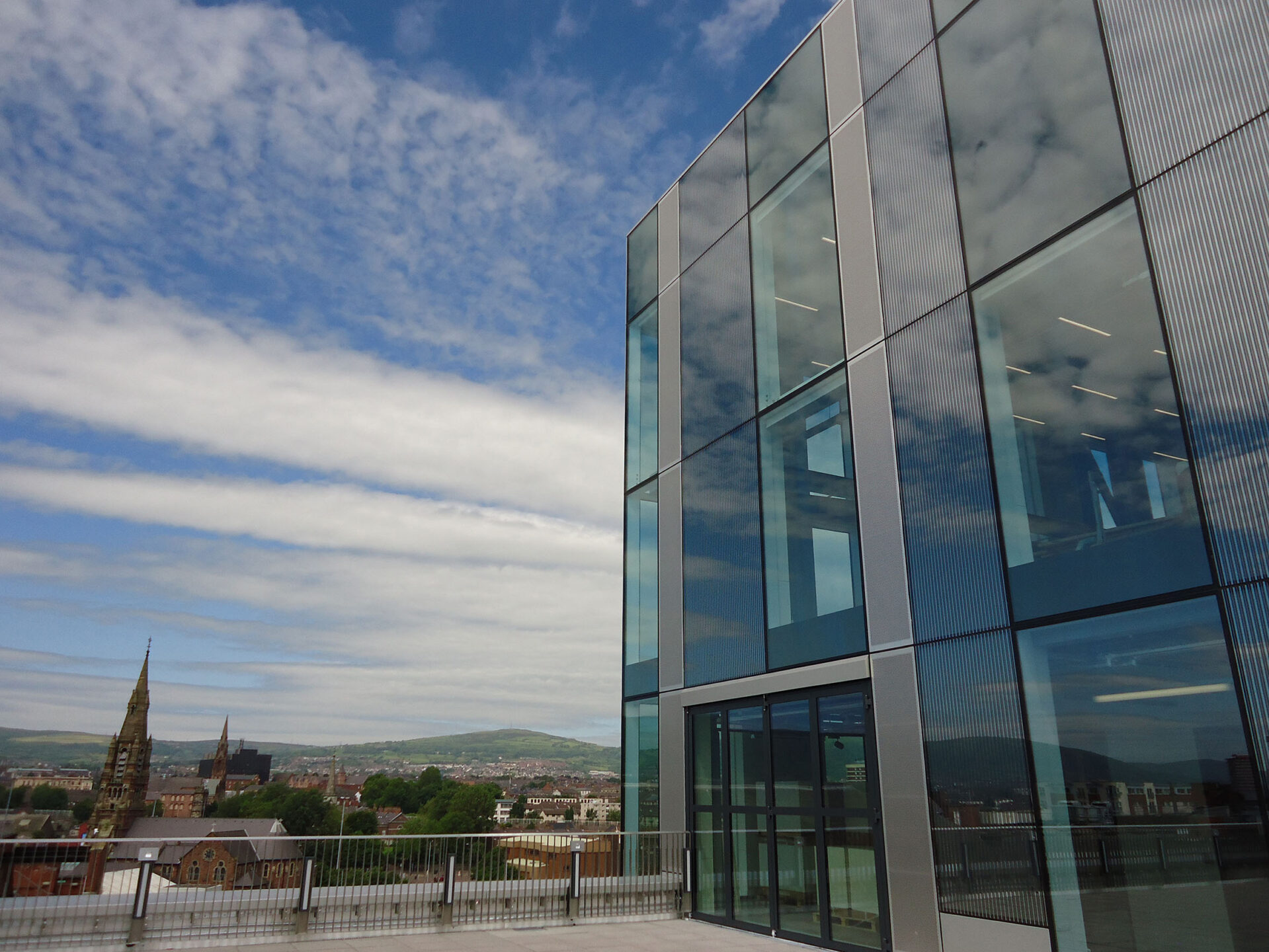
Learning in style in Belfast
Complex glass façade for sun protection, thermal insulation and modern aesthetics: The University of Ulster’s new Belfast campus offers modern facilities spread over an area of around 72,000 square metres for up to 15,000 students and University staff. The project, designed by the architects at Feilden Clegg Bradley Studios, consists of four interconnected buildings between York Street, Frederick Street and Donegall Street – directly opposite the old University building.
The modern glass facade of Block B was constructed by McLaughlin and Harvey using 2,000 square meters of complex glass structures from AGC Interpane’s plants at Lauenförde and Plattling. The project was exemplary for the cooperation it required across several sites: the glazing was coated with highly selective ipasol neutral 60/33 for effective solar control and then processed further with complex screen printing. Some elements were then coated with ipachrome in Plattling. The high-end glass facade lowers the air conditioning requirements in summer and reduces heat loss in winter, thus protecting the environment whilst impressing with its unique design.
Almost ten years ago, in 2006, a report commissioned by the Department of Employment and Learning concluded that the old University building had reached the end of its useful life and was no longer suitable as a modern centre of learning. Various options were considered: demolishing the building, rebuilding it, renovating it or moving some of the University’s activities to another location. In the end it was decided to relocate to nearby York Street as this was found to be the most cost-effective alternative as well as the best one academically. Between 2007 and 2010 the University bought four buildings around the campus: Playboard and York House near the renovated College of Art, the Metropole and the Interpoint Building. The 250-million-pound refurbishment project, which the University expects to finance almost completely over 25 years, could then begin.
Block A has five floors and includes the reception, several auditoriums and the library. It is connected to Block B and other building sections via a skywalk. The six floors that form the base of the nine-storey-high Block B reflect the skyline of York Street. The Centre for Sustainable Technologies conducts research within its walls. The middle storeys stretch across Curtis Street and connect to other buildings. Here, students and staff are busily active in workshops, studios and offices. Storeys seven to nine are unobstructed and provide ample space and light for ateliers. Block C rises from six to eight storeys and contains lecture halls, student facilities, administrative offices, a restaurant and café and plenty of rooms for intensive meetings. Part of the top floor is dedicated to recreational areas and offers the best view of the city. Block D contains, among other things, a car park.
Glass for solar control, thermal insulation, safety and design
For the complicated facades, which provide Block B with lots of daylight, AGC Interpane supplied complex insulating glass structures. Around 720 square metres consist of laminated safety glass made from thermally toughened float glass on the outside. For solar control it is coated with ipasol neutral 60/33, which is particularly colour-neutral (Ra,D = 94) and preserves the transparency of the glass. The solar factor of 33 percent ensures that that the rooms behind the large-area glazing do not overheat, even in summer, which saves on air conditioning costs. On cold days, the low thermal transmittance of 1.0 W/(m²K) of the double-glazing reduces heat loss. In accordance with the facade concept’s focus on light, the glazing provides a relatively high daylight transmission value of TV = 60 percent.
The inner pane consists of eight-millimetre-thick fully tempered glass (with heat-soak test) with anthracite-grey screen printing (RAL 7016). A further 340 square metres of the same structure have screen printing in blue-grey RAL 7031. For increased safety, around 35 square metres of the inner panes are made from laminated safety glass instead of fully tempered glass. One architectural highlight, which also serves to improve the solar control, is the 850 square meters of facade covered in a highly reflective ipachrome Design coating. Interpane Plattling’s chrome-based partial coating is so highly reflective that when viewed from the outside the facade shines in different hues of blue depending on the angle of the sun, constantly presenting a new appearance to the observer.
Construction board
Object address
25-51 York Street, Belfast, County Antrim BT15 1ED
Owner
University of Ulster, Belfast
Architect
Feilden Clegg Bradley Studios
Façade construction
McLaughlin and Harvey
Glass products
ipasol neutral 60/33, ipachrome design, screen printing
Glass processor
AGC Interpane Lauenförde and Plattling
Learning in style in Belfast
Public relations
For editorial queries please contact:
DownloadsDownload all
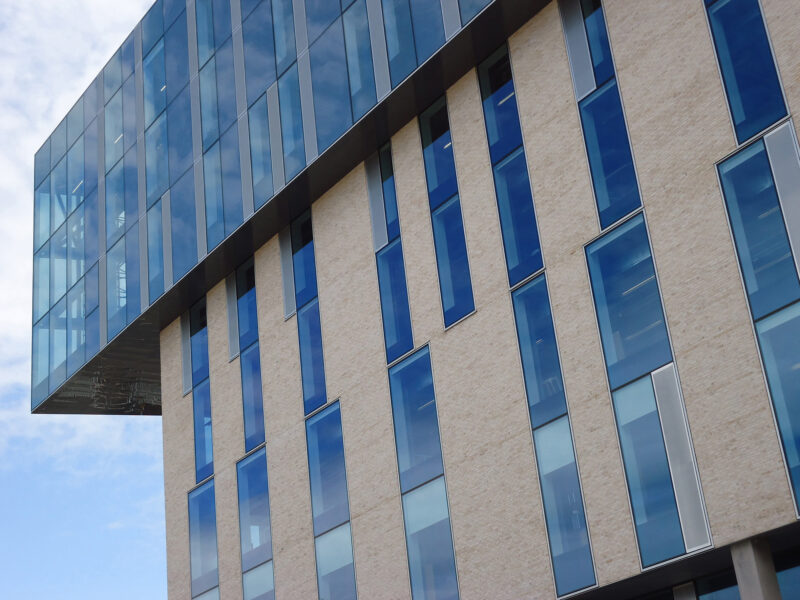 Form, color, variety: ipasol neutral 60/33 allows plenty of daylight into the university's new premises, keeping out the summer heat.
Form, color, variety: ipasol neutral 60/33 allows plenty of daylight into the university's new premises, keeping out the summer heat.
Photo: AGC InterpaneJPEG | 439.47 KB | 1919px x 1440px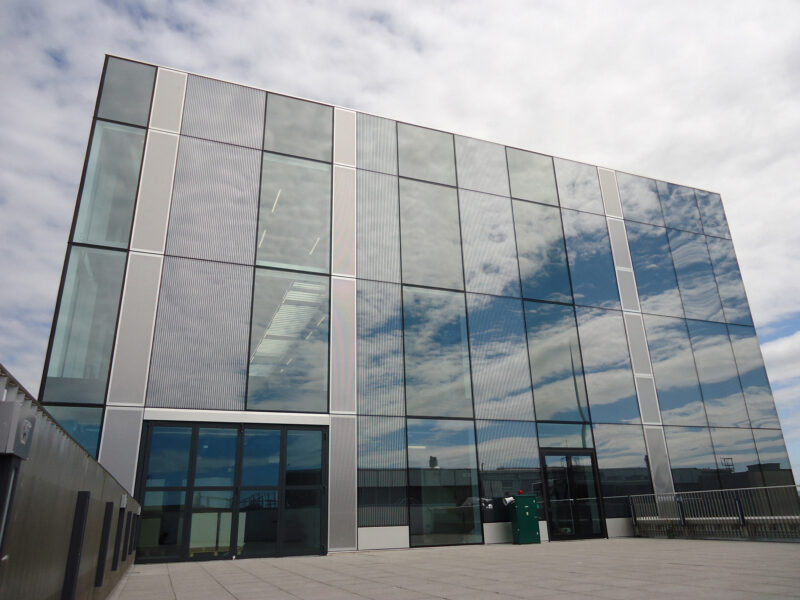 The complex glass façade is an exemplary collaboration between the AGC Interpane sites in Lauenförde and Plattling: it combines ipasol neutral 60/33 solar control glass, screen printing and reflective ipachrome partial coatings.
The complex glass façade is an exemplary collaboration between the AGC Interpane sites in Lauenförde and Plattling: it combines ipasol neutral 60/33 solar control glass, screen printing and reflective ipachrome partial coatings.
Photo: AGC InterpaneJPEG | 397.97 KB | 1919px x 1440px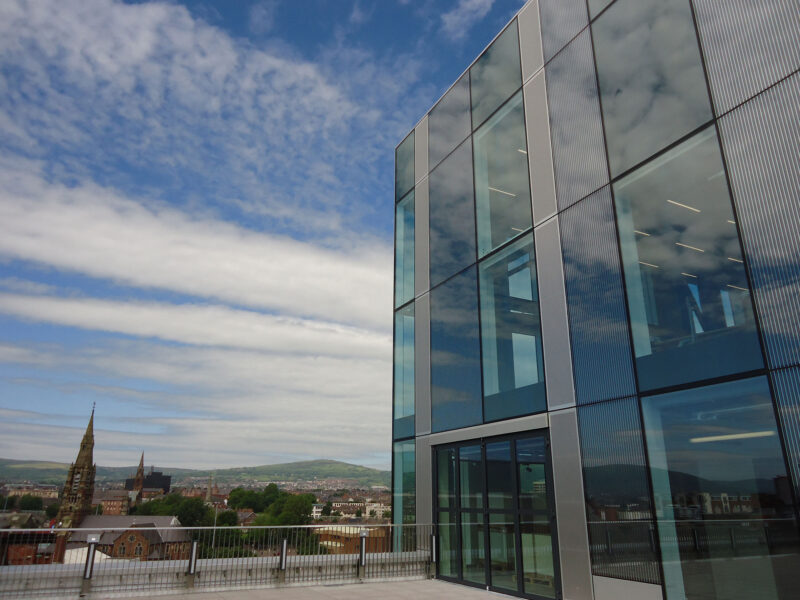 Magnificent view over Belfast.
Magnificent view over Belfast.
Photo: AGC InterpaneJPEG | 422.31 KB | 1919px x 1440px
Copyright notice
Reprint free of charge
Specimen copy requested
AGC Interpane holds all rights to the images in this press section/image database. AGC Interpane permits the use of these images without compensation only when used for their reproduction and dissemination for editorial and press purposes. The images may only be used when shown together with the proper placement/printing of the copyright note “Photo: AGC Interpane”. If an image features a copyright note other than this one, that respective note must be used instead. Any other use of the images, especially their sale and use for advertising purposes, is strictly prohibited. Voucher copy requested.